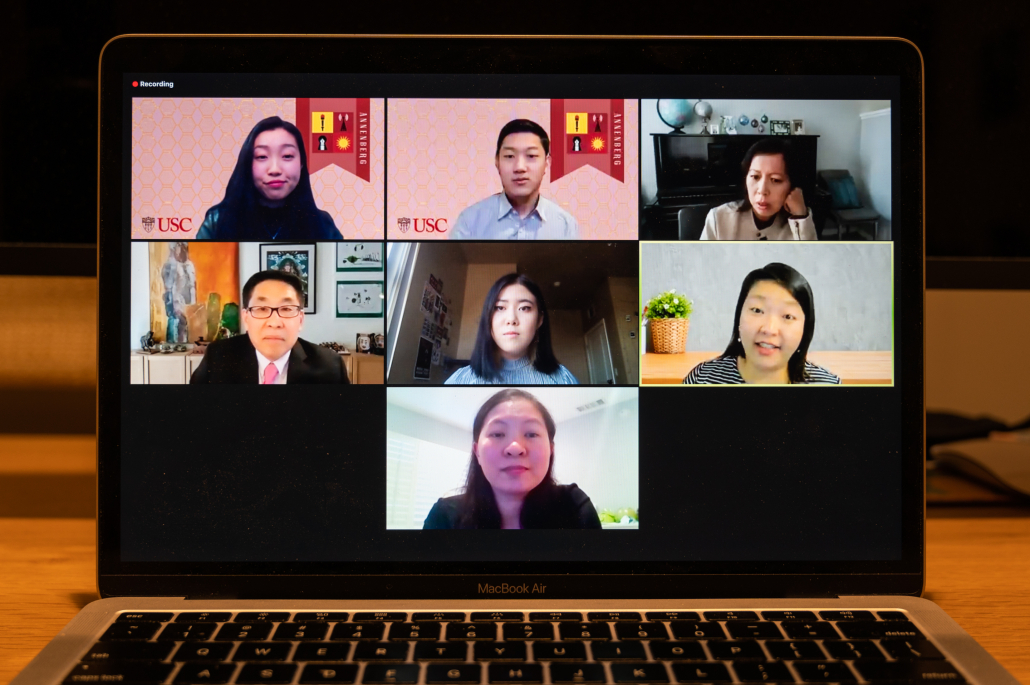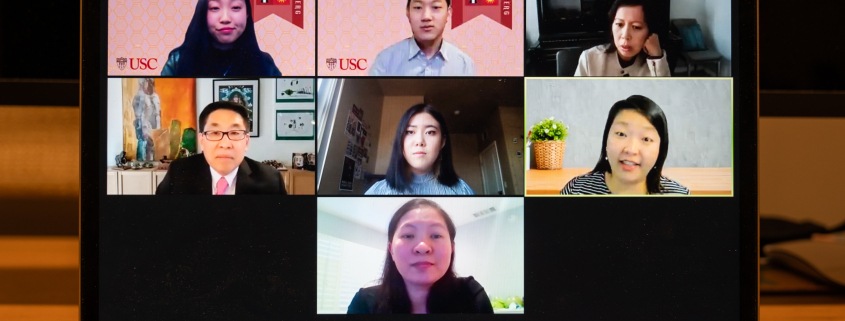Annenberg hosts discussion on anti-Asian racism in and out of media

Following the surge of anti-Asian sentiment since the beginning of the coronavirus pandemic, the USC Annenberg Cross-Cultural Student Association and the USC chapter of the Asian American Journalists Association hosted a virtual event Thursday. The event, “Pandemic Panic: The surging violence against Asian Americans” came after Tuesday’s racially motivated shooting of eight people — six identifying as women of Asian descent —in Atlanta, Ga., and shed light on the racist issues that Asians and Pacific Islanders encounter in their daily lives.
Throughout the pandemic, over 3,500 anti-Asian hate incidents, mostly against women, were reported in the United States, according to NBC News. Asian Americans throughout the nation have experienced verbal harassment, shunning and physical assault.
Panelists Anh Do, Joyce Jang, Jon Funabiki, Dr. Sherry Wang and Christina Yang weighed in their professional perspectives on the importance of addressing racism amongst API victims for an audience of over 150 people.
Wang, an associate professor at Santa Clarita University in the department of counseling psychology, first dove into the idea that AAPI individuals are isolated from Black and Indigenous communities and communities of color because of the model minority stereotype.
“The model minority myth that we are high achieving, that we’re excelling, that it’s a better cultural trait and something that we’re inherently born with — all of which are false, it’s a very colorblind narrative,” Wang said. “When we experience racism, we don’t get the same kind of empathy or even the same kind of listening space … When we do speak up about it, we experience gaslighting.”
Wang said anti-Asian sentiments are “very American” because of the nation’s history of scapegoating Asians, something that has also been seen throughout the pandemic.
“When something is happening in China, or when there is competition with China, it comes back to hurt Americans who are Chinese. It [also] hurts Americans who appear Chinese,” Wang said.
According to Insider, with people such as former president Donald Trump calling the coronavirus the “Chinese Virus” or the “Kung Flu,” racial insensitivity has promoted a lot of racial tension throughout the nation.
Panelists also discussed the shooting of eight people, including six women of Asian descent, in Atlanta Tuesday. Jang, co-president of the USC Student Coalition for Asian Pacific Empowerment, discussed the complexity behind the spa shooting. She said that the shooting was a story about race, gender, fetishization, misogyny, economic exploitation, poverty, colonialism and erasure.
“We need to address that these identities are intersectional, and that, especially regarding Asian women, the U.S. has a history of sexualizing [and] trafficking Asian women during wars, and that trauma from our mothers, our grandmothers, our great grandmothers, can be seen now, and also the attitudes that Americans have towards Asian women really stem from the larger systemic issues that America has,” Jang said.
With the shooting tragedy in mind, the panelists talked about the necessity for current and future journalists to listen to people’s stories, report on them with compassion and build relationships with communities.
“Journalists kind of respond to the next disaster and the next crisis, and then they start to forget, and then the next one happens. What I hope is that journalists will put more time into what they do between the crisis. That’s where it’s [going to] make a difference,” said Funabiki, a retired San Francisco State University journalism professor. “[Media outlets] can start to build these relationships with the community. They can hire more Asian American journalists. They can do more stories about Asian American lives, communities and the real lived experiences, and not simply responding — jump from one crisis to another.”
Funabiki also explained that journalists have a certain duty to the communities they report on.
“We are bound together by these social injustices, and journalists need to accept that responsibility and need to do the kind of coverage that can promote progress,” Funabiki said.
Nathan Hyun, a junior majoring in journalism, moderated the event. In an interview with the Daily Trojan, he said he hopes to bring awareness to the USC community about the issues API individuals currently experience and how they are trying to move forward as a collective unit.
“It’s really important to [care] for others. [It] doesn’t matter if you’re Black, white, Asian … Being understanding of what people are going through and really caring about how people identify themselves and where they’re from — I think more than anything it’s so important to think about that and take that into consideration in everything I do,” Hyun said. “I’m still growing; I’m still learning. I’m still in college but hearing from these outside perspectives tonight was definitely eye opening for me. So I hope in the future, I can definitely be someone who helps others.”
The panel also discussed a possible reason behind the lack of media coverage on marginalized communities is the different levels of diversity in certain communities.
Anh Do, a metro reporter for the Los Angeles Times, said Latinos make up the largest population in L.A. County, so there is a special group of reporters covering Latino issues in the L.A. Times.
“We have quite a number of Asian American reporters at the paper, but instead of being assigned a specialty diversity, it turned out that they’re assigned to cover issues like the environment or earthquakes or coronavirus vaccinations, things like that,” Do said.
Asian Americans, who the panelists discussed as being invisible and overlooked due to the model minority stereotype and scapegoating they experienced throughout U.S. history, have trouble finding allies who can tackle the flaws in society’s system in solidarity with other communities.
“If it has been new for you, that Asian Americans experience racism, then you really haven’t been a safe person for Asian Americans,” Wang said.“You haven’t been someone that Asian Americans have been able to confide [in], in terms of what their experiences have been, as Asian Americans.”
For resources, community members can reach out to Asian Pacific American Student Services, The Student Coalition for Asian Pacific Empowerment, Let’s Talk and the Student Counseling Center.

